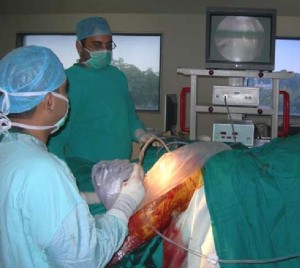Ligament reconstruction involves replacing the torn ligament with a tendon (graft) from your knee or a synthetic material, and attaching the graft in place with screws. This procedure is performed with the use of the arthroscope. The anterior cruciate ligament (ACL) is the most common ligament requiring reconstruction procedures. The torn ligament is excised arthroscopically and new ligament is prepared by ligament grafts taken from your own body. Bony tunnels are prepared in femur and tibia using specialized instruments through which the new ligament is passed and fixed with special screws. This procedure requires relative rest orleave from your work or studies for about 3 weeks after which you will be allowed normal day to day activities.
FAQ
CAN THE MENISCUS BE FIXED ?
The ability of a meniscus tear to heal depends primarily on its blood supply. The outer or thicker part of the meniscus receives a fairly good blood supply from the lining of the joint, whereas the inner or thin part has a poor blood supply. Thus, tears at the outer margin of the meniscus are more amenable to successful repair which can be done by placing sutures across the tear by arthroscopic techniques. If the tear is in the thin part, the cartilage will not heal and the torn fragment is typically excised. Old or chronic tears also tend to have a poorer success rate withrepair and are typically trimmed out as well.
WHAT IS A MENISCUS TEAR ?
The meniscus is a specialized structure that is thicker where it attaches to the lining of the joint and thinner toward the middle of the joint. If you made a cut across it, the meniscus would be triangular or pie shaped.
The meniscus can tear in a number of ways. Tears can result from a sudden twisting-type injury or can occur gradually with age. The tear can be through either the outer thick part or inner thin part. Some tears involve only a small portion of the meniscus, while in others nearly the entire meniscus can be involved.
Meniscus tears can cause symptoms from portions of the torn fragments getting stuck or pulled in between the bones as the knee moves. This can cause snapping or popping, locking, pain, and swelling. Not all meniscus tears cause problems, but when they do the arthroscope can be used to trim out the piece which is torn. Only the portion which is torn is removed.
- Torn Meniscus
- After Arthroscopy
WHAT WILL BE THE DURATION OF HOSPITAL STAY ?
Most of the arthroscopic procedures are performed on day care basis and the patients are usually ready to go home same evening. In cases where ligament reconstructions are performed the patient is discharged within two to three days.
HOW IS ARTHROSCOPY PERFORMED ?
Arthroscopic surgery, although much easier in terms of recovery than open surgery, still requires the use of anaesthetics and the special equipment in a hospital operating room. After arrival, you will be evaluated by a member of the anesthesia team. Arthroscopy can be performed under local, regional, or general anesthesia. Local anesthesia numbs your knee, regional anesthesia numbs you below your waist, and general anesthesia puts you to sleep. The anesthesiologist will help you determine which would be the best for you.
The orthopaedic surgeon will make a few small incisions in your knee. A sterile solution will be used to fill the knee joint and rinse away any cloudy fluid, providing a clear view of your knee.
The surgeon will then insert the arthroscope (telescope) to properly diagnose your problem, using the TV image to guide the arthroscope. If surgical treatment is needed, the surgeon can use a variety of small surgical instruments (e.g., scissors, biters, motorized shavers, or lasers) through another small incision
- Outside View
- Inside View
After arthroscopic surgery, the small incisions will be covered with a dressing. You will be moved from the operating room to a recovery room. Many patients need little or no pain medications.





